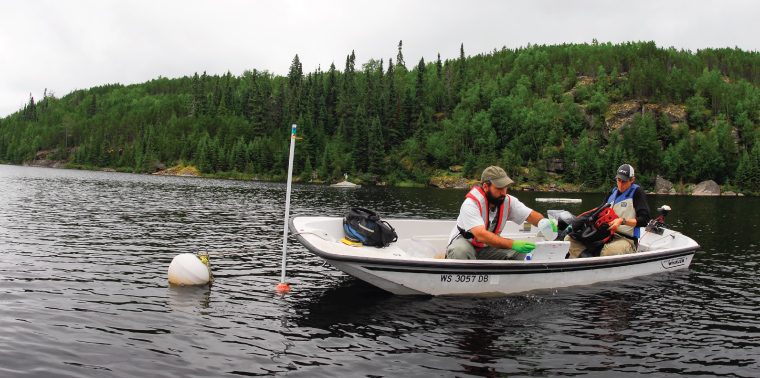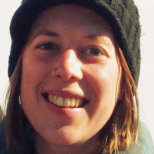January 6, 2014 — The Experimental Lakes Area, a network of 58 lakes in northwestern Ontario that has provided a unique outdoor laboratory for long-term ecological research and monitoring since 1968, recently came dangerously close to shutting down.
The ELA has one of the most complete sets of water quality information in the world and a long history of research on topics that are important to the public and policy-makers, including mercury pollution, harmful algal blooms and the impact of aquaculture on native fish populations. The studies are applicable to lakes on every continent.
Even so, the Canadian government announced in 2012 that it would pull the funding that keeps the field station running to save at least $1.5 million a year, part of a massive austerity plan. The ELA shut down briefly in April 2013 and has been open only on a limited basis since May.
Long-term studies are responsible for the discovery of acid rain, the value of dead wood in forest ecosystems and hundreds of other findings.
“Long-term programs are an easy target,” says Michael Paterson, a veteran researcher at the ELA who served as section leader and senior scientist there from 2006 to 2012. “It’s hard to convince governments that they’re really special.”
But long-term programs are special. So special that researchers like Paterson are taking time away from their work to find a way to keep the ELA alive.
Hundreds of Findings
Long-term studies are responsible for the discovery of acid rain, the value of dead wood in forest ecosystems and hundreds of other findings. Yet, “you have to argue for them all the time,” says Robert Edmonds, a professor emeritus at the University of Washington. “They’re always vulnerable.”
Edmonds has worked on several long-term studies, including the Wind River canopy crane, a 75-meter-high crane with a gondola capable of ferrying researchers through the canopy of a 500-year-old forest in southwestern Washington state. The crane led to the discovery that old growth forests are carbon sinks, absorbing more carbon than they emit. Due to budget cuts in 2011, though, the U.S. Forest Service removed the arm of the crane, which boasted the farthest reach of the nine canopy cranes currently operating worldwide, leaving just a tower at the site.
Although scientific research and monitoring are separate pursuits, most long-term sites support a monitoring program due to the “In ecology, if there’s anything we really need as a serious currency, it’s long-term data.” — Scott Collinsvaluable nature of the data. “The ELA wasn’t created as a monitoring site,” Paterson explains, “but it has become one because of the completeness of the record.” The data sets generated at the ELA and at other long-term sites are coveted by researchers taking on new projects, and can spark research questions that lead in exciting directions.
“In ecology, if there’s anything we really need as a serious currency, it’s long-term data,” says Scott Collins, lead scientist at the Sevilleta Long Term Ecological Research station in New Mexico and current president of the Ecological Society of America. “Ecosystems are so variable.”
If long-term data have proven so important to ecological study, why is long-term funding in danger? One reason, Collins explains, is how agencies handle their budgets. “Funding agencies want to constantly buy into new research,” he says. “If they view their pool of money as fixed, they can only dedicate a small portion of that money to long-term research.” The LTER network, which consists of 26 sites across the United States funded primarily by the National Science Foundation, is a unique situation, he says. Monitoring is an important part of the picture at LTER sites, but the sites are also constantly adding new studies and incorporating short-term research.
“We’re under pressure to distinguish ourselves from other projects,” he says.
Making It Work
Collins points to the National Ecological Observatory Network, a national observatory project scheduled for completion in 2017, as evidence that NSF, at least, cares about long-term projects. The agency provided $434 million out of its infrastructure budget in 2011 for the initial construction at 60 sites across the U.S. Operation and research money, however, will have to come from federal agencies and other funding sources — potentially diverting cash flow from established studies. Some projects have been funded, but it remains to be seen how NEON will integrate with existing research efforts.
The NSF’s vote of confidence is “a gift to the next generation,” Collins says, but will require hard work from the biological community to ensure that it lives up to its potential. “It’s our job to make it the best it can be, and to benefit from it.”
Researchers at the ELA have fought hard for such a show of support. Ecologist Diane Orihel suspended her doctoral work against the advice of her professors at the University of Alberta and founded the Coalition to Save ELA. Meanwhile, Paterson is now serving on the board of the International Institute for Sustainable Development, a privately funded non-governmental organization that has agreed to take over the operation of the site, with promised financial contributions from the provincial governments of Ontario and Manitoba.
The ELA’s temporary closure has handicapped important research, but also raised awareness and demonstrated that the site has support from a broad community.It seems certain now that the ELA will not shut down completely, but the future is still unclear. Researchers will still need to find money for individual projects, and in September, the Canadian government withdrew from its agreement with the province of Ontario that allowed scientists to conduct whole-lake experiments, forcing ongoing studies to remain on hold until legal issues involved are resolved. “I think this is simply a reflection of the government’s desire to extract themselves from ELA and any associated responsibilities,” Paterson says.
The ELA’s temporary closure has handicapped important research, but also raised awareness and demonstrated that the site has support from a broad community. Paterson hopes for a new funding model, one that will allow ELA to be self-sufficient, but he’s not yet sure what that will look like. Whether the money comes from industry, universities, nonprofits or private donors, the hope is that funders can see the value of making a long-term commitment, allowing scientists like Paterson to leave politics behind and return to the work they care about. ![]()
Editor’s note: Amelia Apfel produced this article as a participant in the Ensia Mentor Program. Her mentor for the project was Minnesota-based journalist and author Greg Breining.
Ensia shares solutions-focused stories free of charge through our online magazine and partner media. That means audiences around the world have ready access to stories that can — and do — help them shape a better future. If you value our work, please show your support today.
Yes, I'll support Ensia!
